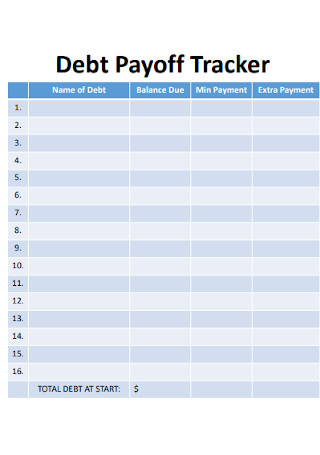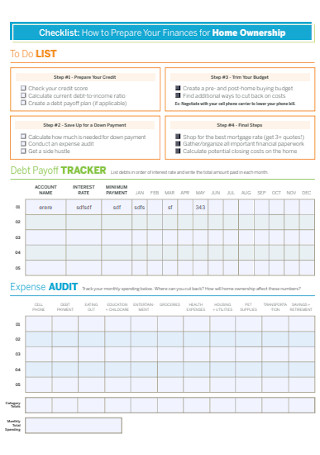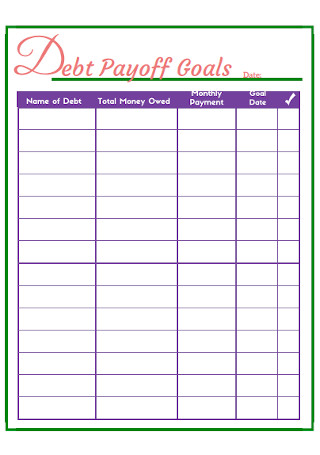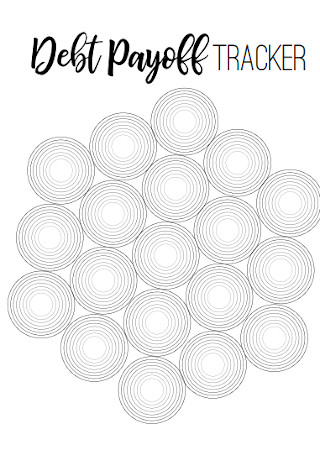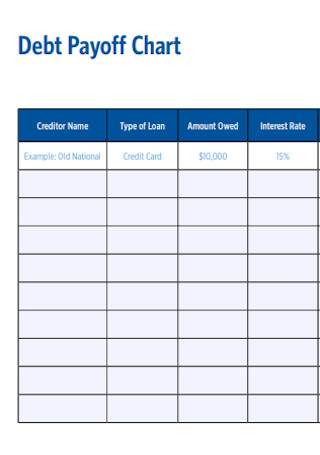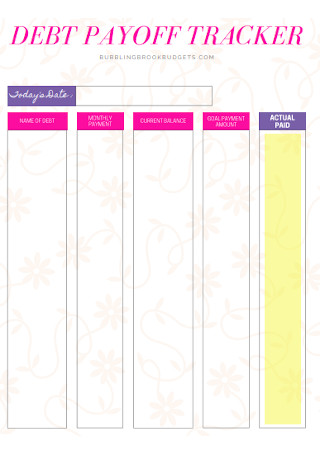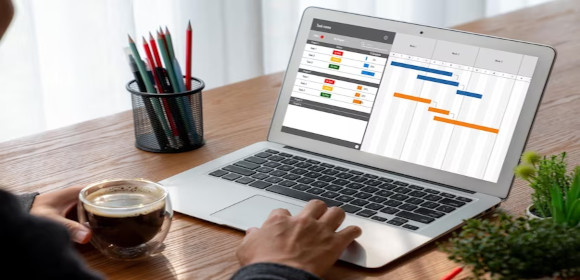With the aim of efficiently managing your projects, a project tracker is a fundamental tool to revolutionize your project management experience. It provides a centralized platform for project planning,…
continue reading
7+ Sample Debt Payoff Trackers
What Is a Debt Payoff Tracker?
A debt payoff tracker or debt payoff planner is an electronic or printable form that you could utilize in order to visibly manage the payments of your debt as well as able to track its progress. Similarly, to using income and expense worksheets in order to have a visual view of your budget, these free printable debt tracker’s here at Sample.Net will help you have that visualization until you are debt free! It offers the same convenience as a mortgage payoff tracker or credit card debt tracker for those that are managing to pay their mortgage or owes the bank. Debt payoff trackers let you remember significant payoffs and keep things in order as it is easy to lose track of your payments or forget your due dates.
As a result of the rising number of loans and debts incurred by the younger generation, particularly due to paying for their education which might exceed their college budget plans, the amount they owed for their student loan debts may escape their minds. According to a recent student loan debt statistics, student loan debt in the United States is expanding six times faster than the nation’s economy, and it could total to $1.73 trillion. And there are around 43.2 million student borrowers, with an average debt of $39,251 per individual. Using a student loan payoff tracker may assist them in settling their debts after graduation.
Types of Debts
Depending on the circumstances and someone’s phase in life, a person may accumulate any type of debt. However, not all debts are created equal. The following are the most common types of debt and their distinctions:
Advantages of Using Debt Payoff Tracker
Tracking something is keeping count of its progress and being up to speed on anything that may happen to it. This is especially handy when you need a visible representation of financial matters such as debts and expenses when you create your household budget worksheets. So, here are some of the reasons why you should utilize a debt payoff tracker to keep track of your debt payments and due dates.
How To Utilize a Debt Payoff Tracker
To effectively pull yourself out of debt, you must make good use of your debt payback tracker. Here’s how it works:
Tip 1: Get the Full Amount of Debt and Its Creditors.
Knowing how much you owe and what you owe is essential for keeping track of your payments. It’s great if you don’t become confused about which quantity of money corresponds to which type of debt as you pay it off. There may have been occasions where a debt was incurred as a result of separate loans with separate creditors. Having a visual reminder of where your money is going will help reduce some of the ambiguity. It will also tell you how much interest you will earn the longer your payment is delayed.
Tip 2: Monthly Minimum Payment Amount
Payment intervals may vary depending on the agreed contract, the minimum amount for each payment should be listed in your debt payoff tracker. Since you are paying your debt in installments rather than in one lump sum, the total amount is only the end-goal. And, while not everyone can pay the precise monthly payment, knowing the minimum payment would assist avoid collectors from seizing your property and earning bad credit for failing to pay on time even if you have previously contributed a specific amount that may, sadly, fall short of the minimum.
Tip 3: Payment Dates.
When you are anticipating many activities and occasions, it is common for things to get tangled up. Days turn into weeks and months without your notice, and you may have missed important occasions thanks to holidays, for example. Having written payment dates in a debt tracker printable will assist you in keeping track of your progress, aligning your other expenses, and managing your budget. Maybe, making a reward chart system for your success will not only encourage you to pay your debt but may also help you recall your payment dates.
Tip 4: Budget
Keeping track of your payments can allow you to better manage your budget. Any predicted expenses will help you anticipate how much money you will have to expend, which you can then sync with your payments. Of course, you want to keep track of your expenditures because it will tell you how much you can save or spend on more costly items. We all have wants, not just necessities, and that may be thwarted if we are suddenly shocked to find ourselves in a relatively substantial debt, possibly due to unpaid dues and a high interest rate. Keeping on track will therefore reduce these chances.
Tip 5: Always Update Your Progress.
A tracker must continuously be updated in order to be effective. Miscalculations or missed expectations may occur as a result of just losing sight of your progress. And it may discourage someone if they see they are not making any progress when they have just forgotten to update. Updating ensures that you know how much debt you owe and how much time you have left to make payments.
FAQs
Why Do People Incur Large Debt?
The dictionary defines debt as “the state of owing someone something that is given with the obligation to repay them.” In essence, this means that you must pay back exactly the amount borrowed. That, however, is not how the financial world works. Depending on the type of loan you accept, there are interest charges that can add up quickly if not paid on time. And if you do not pay the precise amount, the unpaid dues will be carried over to the next month. So, if you have a relatively significant loan at the outset and continue to miss monthly installments and pay even less, your debt will get greater and larger. That is why using and downloading these printable debt payoff trackers from Sample.Net would aid in monitoring and avoiding the accumulation of massive debt.
What Causes Many People to File for Bankruptcy?
People who have accumulated a large amount of debt have the option of declaring bankruptcy in order to clear or lessen their debts. Because declaring bankruptcy protects your assets from seizure by collectors as a result of a significant number of unpaid dues that you cannot afford to repay. Filing for bankruptcy will provide you with a fresh start with regard to your debts. However, it will result in poorer credit scores, which may reduce your chances of borrowing in the future or, in the worst-case scenario, prevent you from getting a job. So, while there are legitimate advantages to filing for bankruptcy, it is preferable if you give it careful consideration.
Are the Debt Payoff Tracker Free?
We have sample documents available for download at Sample.net to serve as the platform for your tracker. These are in the form of debt payoff tracker pdf and printouts, which you can download for free and utilize. You can look through the templates to find the ones that are right for you.
It is not easy to get out of debt. A variety of factors that may result in financial constraints may also contribute to this. Just make sure you do two things: one, pay your debt on time, and second, pay the whole amount of your monthly installments. So, if you’re concerned about debts and how to keep track of them, we have debt payoff tracker samples you may download and utilize. Check them out!
